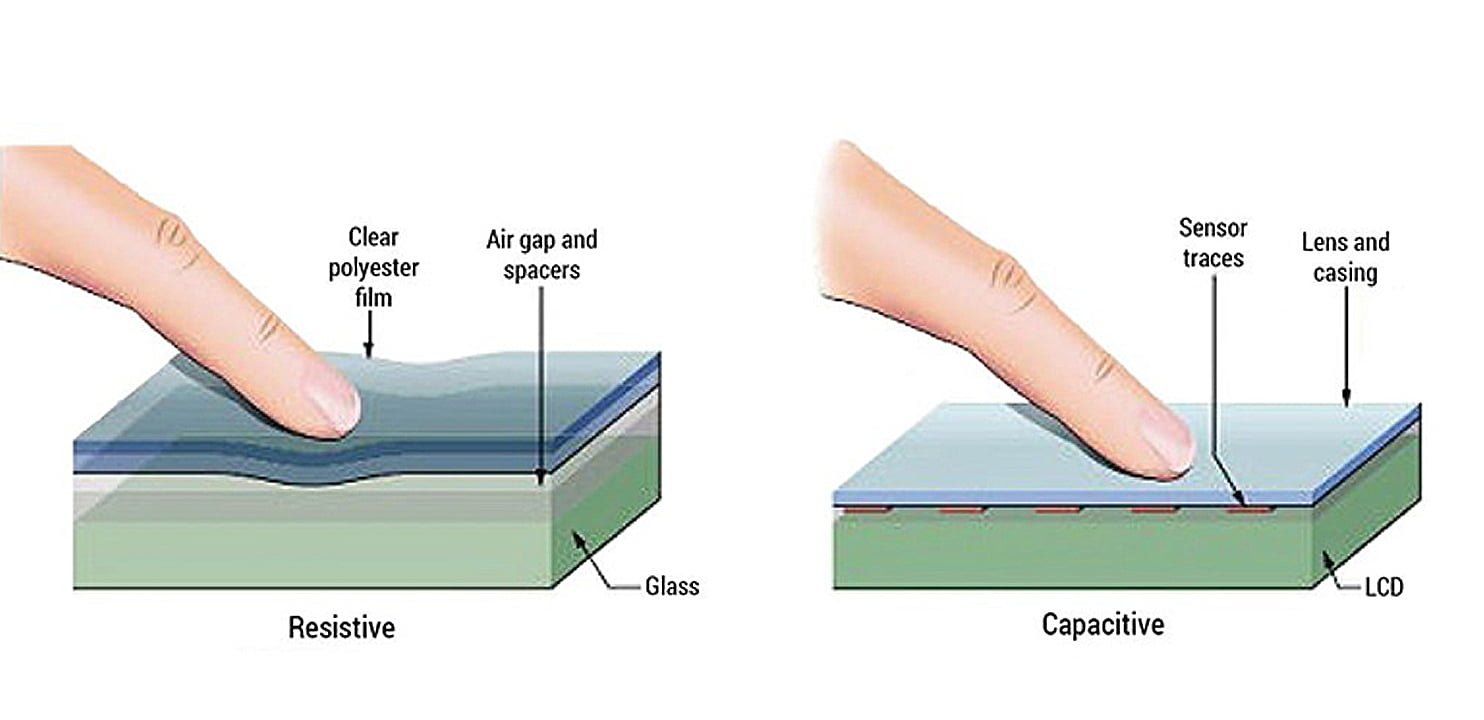There are many types of touch screens on the market, and the more common ones are resistive touch screens (RTP), capacitive touch screens (CTP), surface acoustic wave touch screens, and infrared touch screens. At present, the most widely used touch screens mainly include capacitive touch and resistive touch. The following two types of touch screens are introduced. So that when you want to buy a TFT touch screen, you will more clear that what touch panel you will choose.
What is Resistive Touchscreen?
What is Capacitive Touchscreen?
What is the difference between capacitive touchscreen and resistive touchscreen?
The Advantage and disadvantage of Capacitive Touchscreen
The Advantage and disadvantage of Resistive Touchscreen
Resistive Touchscreen(RTP)
Resistive touchscreen(RTP) controlled by pressure sensing. The structure is divided into three layers, the inner layer is glass, the outer layer is a film, and ITO (indium tin metal oxide) is coated on the adjacent side of the film and the glass. When the touch operation is performed, the ITO on the lower layer of the film will contact the ITO on the upper layer of the glass, and the corresponding electrical signal will be transmitted through the sensor, sent to the processor through the conversion circuit, and converted into the X and Y values on the screen through operation, the selected action is displayed on the screen.
Capacitive Touchscreen(CTP)
Capacitive touchscreen(CTP) is It is a four-layer composite glass screen, the first layer is ITO to ensure the working environment, the second layer is glass, the third layer is also ITO coating, used for working surfaces; the fourth layer is silica glass protective layer. When the finger touches the metal layer, the capacitance of the contact will change, so that the frequency of the oscillator connected to it will change. By measuring the frequency change, the touch position can be determined to obtain information.

If you need to check Touchscreen Panel, you could click here to check.
What is the difference between capacitive touchscreen and resistive touchscreen?
1:touch technology
- Capacitive screen: support multi-touch, fast response and responsive.
- Resistive screen: pressure sensitive, can be touched with any object.
2:Use environment
- Capacitive screen: easily affected by changes in environmental temperature, humidity, electric field and other factors, we can optimize the display according to the usage scenario.
- Resistive screen: The screen is not easily affected by dust, water vapor and oil pollution, can be used in a lower or higher temperature environment, and can adapt to harsh environments.
3:Cost
- Capacitive screen: The cost is higher than that of resistive touch technology.
- Resistive screen: Since the capacitive touch technology is very mature, the structure is simple, and the technical threshold is low, the cost is low.
4:lifetime
- Capacitive screen: Capacitive touch technology works by using current sensing, which has less wear and tear on the screen and has a long service life.
- Resistive screen: Resistive touch technology uses pressure sensing, which is easy to wear and tear the screen, resulting in damage to the touch function and short service life.
| Resistive Touch | Capacitive Touch | |
| Cost | Cheap | Expensive |
| Muti-touch | NO | YES |
| Touch Durability | 3H | Can reach to 9H |
| Touch Sensitivity | Low | High(adjust) |
| Touch Object | Anything | Finger. Can be designed to use other materials such as gloves, stylus, pencils, etc. |
| Function Sensitive to EMI/RFI | Low sensive | High sensive (Shielding must be designed) |
The Advantage and disadvantage of Capacitive Touchscreen
Advantages:
- Better clarity and image quality: Capacitive screens do not require a separate overlay, leading to better visual clarity and light transmission.
- Multi-touch support: Capacitive screens can detect multiple touch points simultaneously, enabling multi-finger gestures like pinch-to-zoom or two-finger scrolling.
- More durable and resistant to wear: Capacitive screens do not have layers that can wear out over time, making them more durable and long-lasting.
- Faster and more responsive: Capacitive touch screens generally offer faster response times, leading to a smoother user experience.
Disadvantages:
- Requires conductive input: Capacitive touch screens can only be operated with conductive materials like fingers or capacitive styluses. They do not respond to non-conductive objects like gloved fingers.
- Cost: Capacitive touch screens tend to be more expensive to manufacture compared to resistive touch screens.
The Advantage and disadvantage of Resistive Touchscreen
Advantages:
- Operable with any input: Resistive touch screens can be operated with any object that applies pressure, including fingers, gloves, styluses, or even a pen.
- Lower cost: Resistive touch screens are generally more cost-effective to produce, making them a popular choice for budget-friendly devices.
- Good for handwriting recognition: The ability to use a stylus or pen makes resistive screens suitable for applications that require handwriting recognition.
Disadvantages:
- Lower image quality: Resistive touch screens typically have an additional layer that can reduce visual clarity and light transmission.
- Single-touch input: Most resistive touch screens can only detect a single touch point at a time, limiting multi-touch capabilities and gestures.
- Less durable: The flexible layers in resistive touch screens are more susceptible to wear and tear over time, potentially reducing their lifespan.
RJOYTEK custom different type TFT LCD touch panel, whatever resistive touch panel or capacitive touch panel, you could choose according to your projects, anyway, we also custom different size tft lcd display, display brightness and different interface or provide different control board such as HDMI board, USB driver board.
If you need any help, than email us!
LCD Touchscreen Recommendation
 |
 |
 |
| 7 inch 1200*1920 TFT LCD Touchscreen | 10.25 inch Automotive LCD Screen Touch Display | Small size 1.3 inch TFT Touchscreen Panel |

